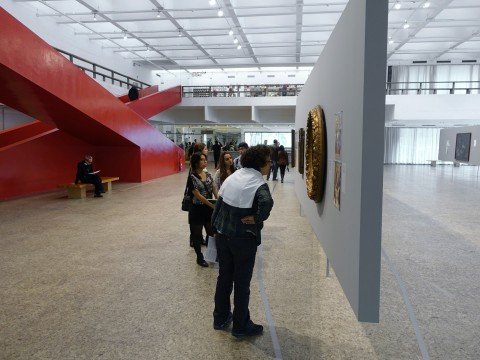Museu de Arte de São Paulo inspects its former director Pietro Maria Bardi
- Visitor at MASP in Rua 7 de Abril, 1950.
- Art from Italy: From Raphael to Titian, installation view at MASP.
- Sandro Botticelli and studio, Virgin and child with the infant St. John the Baptist, 1490/1500.
- Art from Italy: From Raphael to Titian, installation view at MASP.
- Giovanni Bellini, Virgin with standing Child, 1480/1900.
- Maestro di San Martino alla Palma, The virgin and the Child, 1310/1320.
- Perugino (copy from), San Sebastian , after 1495.
“A new museum has been created in Brazil. This is a limitless, undiscovered country, whose impenetrable forests and great rivers present obstacles to the would-be explorer that pull him up sharply at what is, in fact, the very starting-point of art: an immense chaos of natural beauty which holds in its depths an elusive population of Indians whose art is still in the prehistoric stage”. With these words Pietro Maria Bardi, founder along with Assis Chateaubriand of the Museo de Arte de São Paulo and its director for 45 years, presented the brand-new art institution to the readers of the magazine Art News (Building a museum on virgin soil, New York, March 1957).
At that time he was a former journalist who emigrated from Italy to Brazil after the second world war because of his fascist faith while Chateaubriand, a former journalist too, was the owner of media empire rapidly expanding. Bardi’s wife, architect Lina Bo, designed the MASP building as a monumental treasure-chest nestled in a couple of red, iconic “U” structures.
Now, those “Indians” are not at the prehistoric stage anymore. On the contrary, contemporary Brazilian artists – and art dealers – are respected all over the word. Thus, this going back to the roots of the brazilian art system may indeed seem like a revenge. Bardi’s article, as well as many other papers documenting his cultural activism, is indeed on exhibition at the MASP along with some of the most important acquisitions of Italian art Bardi purchased during his mandate, including big names such as Andrea Mantegna, Giovanni Bellini, Sandro Botticelii, Tiziano, or Jacopo da Bassano (Art from Italy: from Raphael to Titian, until 20 September).
One again Bardi’s wife is on the background. In effect the exhibition re-enacts two historical settings Lina Bo made in 1947 and in 1957 employing the same metal tubular structures she designed to display paintings at the MASP original location (on rua 7 de Abril), and the long grey panels conceived in occasion of the show of the Museum’s collection at Fundação Armando Alvares Penteado.
Even if some attributions have been questioned in the meantime, and the quality of some paintings may not be that hight, the MASP can still be proud of its remarkable collection of Italian art. The revenge against Bardi would not take place by putting him down and taking distance from his colonialist and family driven point of view. Indians are now much more sophisticated. In point of fact, the revenge lies in the way Renaissance art in the hands of those who were once supposed to be in the need of education and culture is now described -from the exhibition’s introductory text: “the works in the exhibition were produced in the region known as Italy, but until the 19th century it was a cluster of small states, ruled by independent local authorities, the Catholic Church, or by foreign powers”. More or less like today, especially with regards to the third point, foreign powers.
And if this is not convincing enough, please have a look at the astonishing group of paintings by Manet, Van Gogh, Gauguin, Modigliani and Matisse in the MASP collection. They have been purchased, or given to the museum by private donors, during fifty years of extraordinary growth. The country from which the proud Pietro Maria Bardi escaped can’t even compete with them.
July 3, 2015








